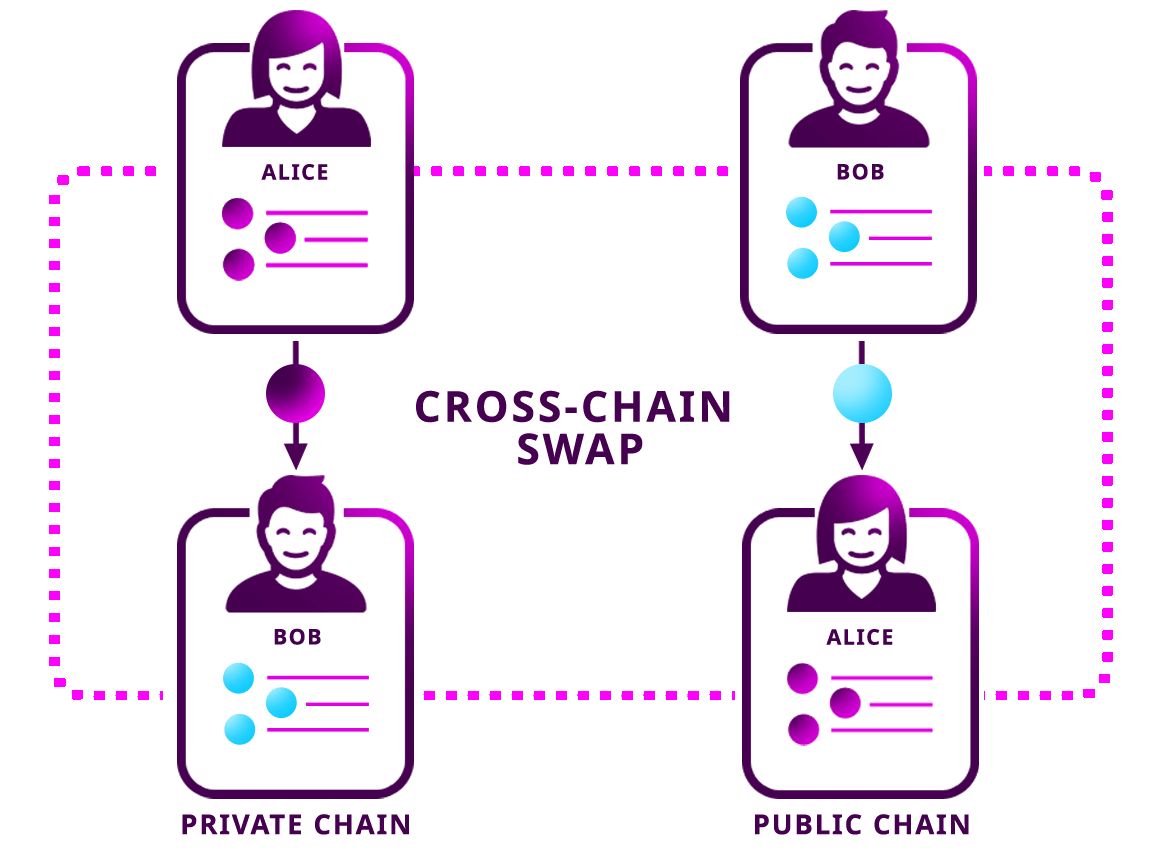A cross-chain swap enables trading tokens across different blockchains without using an intermediary party (e.g. an exchange service) in the process.
Protocol
Alice and Bob want to exchange 10 alice.tokens for 10 bob.tokens.
The problem is that they are not in the same network: alice.token is defined in Symbol’s public chain whereas bob.token is only present in a private chain using Symbol tech.
Trading tokens directly from one blockchain to the other is not possible, due to the technological differences between them.
In the case of Symbol public and private chain, the same mosaic name could have a different definition and distribution or even not exist.
Between Bitcoin and Symbol, the difference is even more evident, as each blockchain uses an entirely different technology.
Instead of transferring tokens between different chains literally, the trade will be performed inside each chain.
The cross chan swap protocol will ensure that the token swap occurs atomically.
Before starting with the swap, all participants involved int the swap must own at least one account in each blockchain.
- Alice generates a random set of bytes called
proof. The proof should have a size between 10 and 1000 bytes.
- Alice hashes the obtained proof with one of the available algorithms to generate the
secret.
- Alice defines the SecretLockTransaction TX1:
| TX1 Property |
Value |
|---|
| Type |
SecretLockTransaction |
| Mosaic |
10 alice.token |
| Recipient |
Bob’s address (Private Chain) |
| Algorithm |
h |
| Duration |
96 h |
| Secret |
h(proof) |
| Network |
Private Chain |
Once announced, this transaction will remain locked until someone discovers the proof that matches the secret. If no one unlocks it before the duration set is reached, the locked funds will be returned back to Alice.
- Alice announces TX1 to the private network and shares with Bob the secret.
Note
Bob should retrieve the secret from the chain. It is Bob’s responsibility to verify the secret correctness.
- Bob defines announces the following SecretLockTransaction TX2 to the public network:
| TX2 Property |
Value |
|---|
| Type |
SecretLockTransaction |
| Mosaic |
10 bob.token |
| Recipient |
Alice’s address (Public Chain) |
| Algorithm |
h |
| Duration |
84 h |
| Secret |
h(proof) |
| Network |
Public Chain |
- Alice announces the SecretProofTransaction TX3 to the public network. This transaction defines the encrypting algorithm used, the original proof and the secret:
| TX3 Property |
Value |
|---|
| Type |
SecretProofTransaction |
| Recipient |
Alice’s address (Public Chain) |
| Algorithm |
h |
| Secret |
h(proof) |
| Proof |
proof |
| Network |
Public Chain |
- Once TX3 is confirmed, the proof is revealed. TX2 transaction is unlocked, and Alice receives the locked funds.
- Bob picks the proof and announces the SecretProofTransaction TX4 to the private network, receiving the locked funds from TX1.
| TX4 Property |
Value |
|---|
| Type |
SecretProofTransaction |
| Recipient |
Bob’s address (Private Chain) |
| Algorithm |
h |
| Secret |
h(proof) |
| Proof |
proof |
| Network |
Private Chain |
The process is atomic, but should be completed with lots of time before the deadlines:
- TX1’s duration should be significantly bigger than TX2’s to guarantee that the second participant will have time to unlock TX1 after the first one reveals the proof.
- Each participant must wait for at least
maxRollBackBlocks between announcements to prevent experiencing transaction rollbacks.
